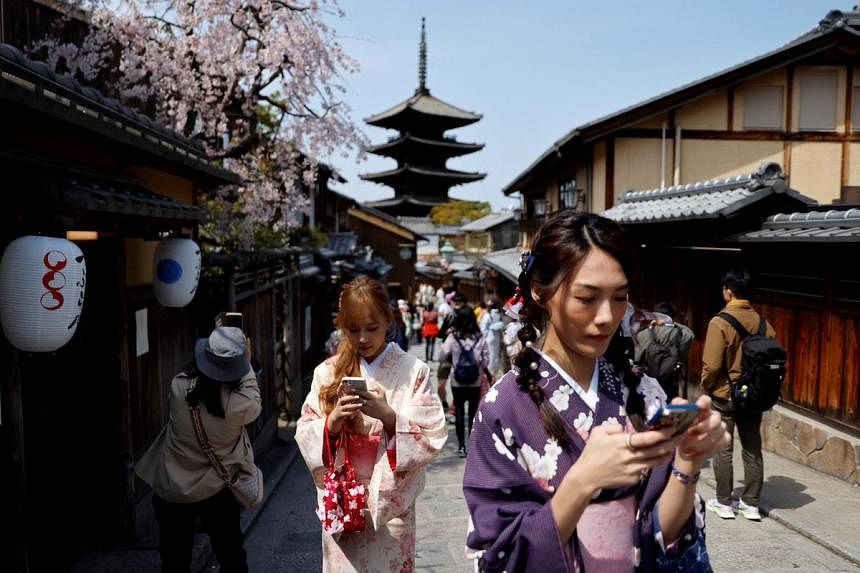KYOTO – It is not uncommon in Kyoto today for residents to have to wait for three or four packed buses to pass before being able to get on themselves. Once on board, they often cannot get a seat, and find themselves jostling for room with not just passengers but also large suitcases.
The problem is worsening as the number of tourists rapidly increases, putting severe strain on the ancient Japanese city’s transportation infrastructure.
Public anger is so acute that it helped propel Kyoto’s new mayor, whose campaign pledged to fight against the excesses of tourism, to victory in elections in February.
“I’ve had many complaints from locals asking me to please do something about the public transportation,” said Mr Koji Matsui, an independent who was once deputy chief Cabinet secretary in the national government.
“The structure of Kyoto is that there is a lot of overlap between tourist destinations and the areas in which ordinary people live their lives.”
Kyoto prefecture, which includes the city, has a population of about 2.5 million, but drew some 32 million overnight guests in 2023.
The figure reflects the surge in foreign tourists, thanks in large part to the weak yen, though Kyoto is a major domestic travel destination as well.
And while other cities in the world are also struggling with the problem of over tourism, Kyoto presents a different challenge because of its size and layout.
“I don’t think that people really take a lot of buses inside Venice, for example,” said Dr Jan-Dirk Schmocker, an associate professor at the University of Kyoto who specialises in urban management and public transportation.
“It’s a bit different in European cities where you have a nice old town and people go there and then walk. But here, you have distances between the different sites.”
Kyoto is home to 17 Unesco World Cultural Heritage Sites and other famous spots like the bamboo forests of Arashiyama, sprawled across an area about 14 times the size of Manhattan, making walking from point to point hard. At the same time, the ancient capital is smaller than big metropolises, like Tokyo, where visitors can be more dispersed.
Most people in Kyoto rely on the bus network because the city has only two subway lines, which do not stop directly in front of top destinations such as the Golden Pavilion, or Kinkaku-ji.
Still, the train is not much better – the JR Sagano Line, which people use to get to Arashiyama, is also often jam-packed.
“The lines are super long and I often can’t sit,” said 24-year-old Seira Yamagishi, who works in an antique store in Kyoto. “Such a huge number of visitors causes trouble for the citizens, so I can’t say that tourism is definitely a good thing for Kyoto.”
These sentiment highlights how tourism is viewed as a mixed blessing for Kyoto. On the one hand, the economic impact from visitors is huge, reaching 1.1 trillion yen (S$9.63 billion) in 2022, according to the city.
On the other, resentment is growing around problems that come with mass tourism – sometimes called “tourism pollution” in Japan – beyond just transportation.
For example, the city has banned people from entering the narrow private streets in the Gion district, where tourists harassing and chasing after geisha for photos are now termed “geisha paparazzi”.
Ms Azusa Takemura, a 23-year-old hotel worker in Kyoto, said that even though the tourism boom has meant higher bonuses for employees, the government needs to come up with measures to combat overtourism instead of just focusing on the economic benefits.
“It’s not just the fact that there are a lot of people, but also the etiquette of foreign tourists in the buses and trains is something I’m concerned about,” she added.
The city has tried various fixes, such as stopping the sale of one-day bus passes so that travellers would opt for the train. A more unconventional idea involved putting ninja statues at the end of a train platform to lure tourists to less crowded carriages.
Currently, Kyoto is working to implement changes such as building new ticket gates in the main train station, while also promoting bikes and walking, sightseeing during off-peak hours and using lockers or services that transport luggage for tourists.
Mr Matsui is also launching an express bus that is priced higher than normal buses starting in June, with routes that go only to tourist sites, bypassing other stops.
But he admits that the new policy is not sufficient. “It’s one method to slightly ease the pain for both locals and tourists who have to deal with waiting for the buses. It’s not something that will solve the real problem of a high concentration of tourists.”
Ideally, Mr Matsui says he wants tourists to explore off-the-beaten-track spots and stay in Kyoto for longer periods to reduce congestion.
But with Kyoto known for specific sites like its bamboo forests or the red torii gates of Fushimi Inari – places made all the more famous as foreign celebrities from Kim Kardashian to Neil Patrick Harris flock to Japan – his wish could be a tall order.
The sites “are famous for a reason, but on the other side, it’s really reinforcing itself. Because many people go there, then even more people go there”, said Kyoto University’s Dr Schmocker. “Trying to break that feedback loop – that should really be the objective.”
Ultimately, the new mayor says he does not want Kyoto to become a place where citizens do not want foreigners to come any more, as evidenced in protests against tourism that have erupted in some European cities.
“It’s important for a wide range of citizens to understand the meaning and benefits of having tourists come to Kyoto,” said Mr Matsui. “We can’t let hatred towards tourists spread among the citizens.” BLOOMBERG

